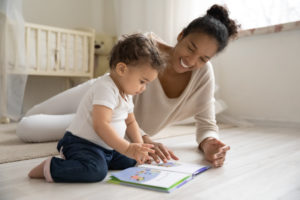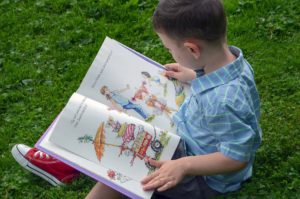Strategies And Tips To Support Shared Book Reading
The importance of reading with your child is well known! It provides an opportunity for caregivers to connect with children and create a language enriched environment.
Books expose children to a range of ideas, words and experiences and provide opportunities for the development of language skills, vocabulary, early print awareness (e.g., letters, words and sentences) and phonological awareness (e.g., rhyming).
Why read books?
A 2020 study by Clemens and Kegel measured language use and interactions between parents and children in shared book reading activities and compared this to language use and interactions in other activities.
They found that shared book reading experiences led to increased conversational turns and child vocalisations in children as young as 9 months, compared to singing songs, playing with toys and daily routines.
They found that books provided a base or structure for parents to build on when interacting with their child.

Sharing a story with your child can build a range of language and early literacy skills, including:
- Vocabulary development.
- Development of grammar.
- Understanding and answering questions.
- Narrative development (storytelling).
- Conversation skills.
- Phonological awareness (rhyming and alliteration).
- Print awareness.
How to get the most out of shared book reading
Getting Ready
Reduce distractions, such as turning off the TV or putting down your phone, to create a space and time to connect with your child. Get comfortable and have your child sit next to you when reading, instead of in your lap. This allows you to see your child’s face, and for them to see your face while you read the story.
Choosing Books
When selecting books, look for those with a rich vocabulary that includes different words from what you use every day. Choose stories with a clear narrative structure, featuring characters, settings, a problem, a plan, attempts to solve the problem, and a resolution. Also, consider books that include perspective words, emotional vocabulary, and thinking words. For more tips, watch this video from Marion about how to choose books.
Engaging and Connecting
Engage and connect with your child through shared book reading by taking turns with the story.
Watch and listen to their input, allowing them to make comments and ask questions.
Encourage turn-taking by asking questions, relating the story to their own experiences, and pointing or making gestures to pictures. For little ones who aren’t yet talking, they can participate by looking, pointing or gesturing, smiling, or making sounds.
Make the experience fun by using different voices for the characters, adding sound effects like animal noises and words like “crash!” or “bang!” and using gestures, actions, and facial expressions to bring the story to life.
Express the emotions and characteristics of the story’s characters with your face and voice. Using fun and exciting tones and expressions can help your child stay engaged in the story longer and learn to anticipate what’s coming next.
Reading the Story
Did you know that when you’re reading with your child, you don’t always have to read the words? Reading the book’s text is a great way to introduce new vocabulary, and books with rhyme or alliteration can support phonological awareness. To support learning of new words, you can:
- Get your child to say the word.
- Discuss words that are similar and opposite.
- Show them how to use it in a sentence.
- Try to use that word throughout the week in different situations.
Adding your own words to talk about the story pictures is another way to share a story—comment on what you can see and what you know about the items or people in the pictures.
Making comments and asking questions
When reading, it can be really tempting to ask lots of questions while looking at pictures and talking about what is going on in the book, but this is not always the most helpful way to engage children and enjoy book reading time. Balance your questions and comments using the rule of five: four comments for every one question.
- LOOK at the pictures of the book, follow your child’s point or eyes, and talk or label what is happening.
- TALK about what you can see happening in the picture.
- THINK—encourage your child to think about the pictures or what might be there (e.g., lift the flaps—“Oh! There’s something under the bush. I wonder what it is”).
- TELL—tell a story or relate to the pictures. Talk about a time where they can relate (e.g., “I remember when we saw a sheep at the farm!”).
- ASK—ask a question about something they can see, know, or think about the book (e.g., “I wonder what it would sound like. Can you make a sheep sound?”).
When the story is finished
The learning doesn’t have to stop when the story is finished! Summarise the story with your child, talk about the elements of the narrative (see below) and see if they can retell the story to you. You could also talk about what might happen next, share your opinions about the book or talk about what you would do if you were the character.
Key narrative elements include:
- Beginning: Who (characters), what, where (setting), and when the story takes place.
- Middle: The problem of the story, feelings, and actions the characters take to solve the problem.
- End: Where the problem does/doesn’t get fixed and usually more thoughts and feelings by the characters.
Don’t forget, the most important thing is to connect with your child, and have fun! Sharing books is a wonderful way to learn about new ideas, and experiences together.
If you are concerned for your child’s development or would like further information regarding therapy or the intervention process, please don’t hesitate to get in touch with our Northside Speech Pathologists and/or Occupational Therapists via [email protected] or call us at the clinic on (07) 3265 4495.

Written by Tess Marson
Speech Pathologist
